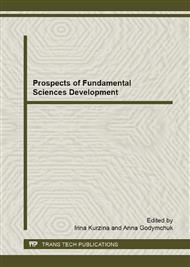[1]
V.E. Gunter, Shape memory materials and new technologies in medicine, NPP «MIC», Tomsk, (2010).
Google Scholar
[2]
V.E. Gunter, Shape memory materials and new technologies in medicine, NPP «MIC», Tomsk, (2007).
Google Scholar
[3]
V.E. Gunter, V.N. Khodorenko, T.L. Chekalkin, Medical materials with shape memory, Medical materials and shape memory implants, first ed., NPP «MIC», Tomsk, (2011).
Google Scholar
[4]
V.E. Gunter, Biocompatible materials with shape memory and new technologies in dentistry, NPP «MIC», Tomsk, (2006).
Google Scholar
[5]
V.N. Khodorenko, A.V. Gunter, A.A. Radkevich, Biocompatibility of fine-grained porous NiTi with biological tissues, Shape memory materials and new technologies in medicine, (2004).
Google Scholar
[6]
O.V. Kokorev, V.N. Khodorenko, S.G. Anikeev, Study of the behavior of mesenchymal stem cells in the bone marrow of porous permeable incubators of NiTi, NTL, Herald of New Med. Technol. 19, 1 (2012) 32-36.
Google Scholar
[7]
O.V. Kokorev, V.N. Khodorenko, G.Z. Dambaev, Comprehensive assessment of the development of hepatocytes in the porous-permeable incubators of NiTi, Siberian J. of Medicine. 27, 1 (2012) 130-36.
Google Scholar
[8]
O.V. Kokorev, G.Z. Dambaev, V.N. Khodorenko, V.E. Gunter, Porous-permeable incubators of NiTi in cell technologies, Cellular Transplantology and Tissue Eng. 1-2 (2010) 68-76.
Google Scholar
[9]
K. Otsuka, X. Ren, Physical metallurgy of Ti–Ni-based shape memory alloys, Progress in Materials Science (2005).
DOI: 10.1016/j.pmatsci.2004.10.001
Google Scholar
[10]
V.I. Itin, Y.S. Naiborodenko, High-temperature synthesis of intermetallic compounds, TSU, Tomsk, (1989).
Google Scholar
[11]
A.P. Savickii, Liquid-phase sintering systems with interacting component, Science Siberian Branch, Novosibirsk, (1991).
Google Scholar
[12]
Y.F. Yasenchuk, V.N. Khodorenko, V.E. Gunter: Segregation of titanium during heat treatment of porous NiTi, Shape memory materials and new technologies in medicine (2004).
Google Scholar
[13]
V.E. Gunter, Metallography in medicine and especially the deformation behavior of materials and implants superelastic shape memory, Implants with Shape Memory. 1-2 (2012) 98-110.
Google Scholar
[14]
S.P. Belyaev, F.Z. Gilmutdinov, O.M. Komunnikova, Investigation of the processes of oxidation and segregation on the surface of NiTi, Letters to Technical Physics Letters. 25-13 (1999) 84-89.
Google Scholar
[15]
U.F. Yasenchuk, V.N. Khodorenko, V.E. Gunter, Segregation in the heat treatment of titanium porous NiTi, Implants with Shape Memory. 1-2 (2005) 14-18.
Google Scholar
[16]
A.N. Monogenov, N.V. Artyuhova, Y.F. Yasenchuk, Mechanical properties of porous NiTi aluminum-doped, Fund. Problems of Modern Mater. 63 (2009) 59-64.
Google Scholar


